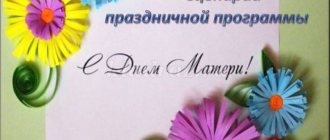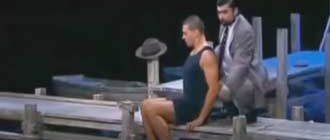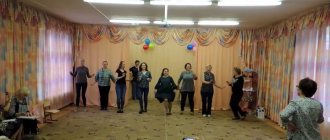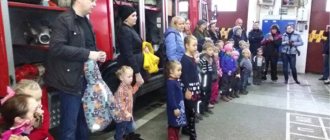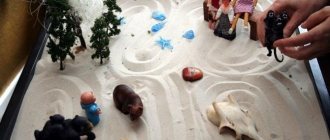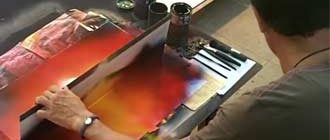MAGAZINE Preschooler.RF
Project “All professions are needed, all professions are important.”(Middle group)
Implementation timeframe: long-term (6 months).
Project type: educational, informational, creative, group.
Author of the project: Shompolova A.V.
Participants in the project activities: teachers, children and parents of the middle group, invited guests of various professions.
Relevance of the project:
In preschool age, further familiarization with the world of adults and objects created by their labor acquires special importance for the full development of a child’s personality. Familiarization with the professions of parents ensures the child’s further entry into the modern world and familiarization with its values. That's why the idea of creating this project arose. An in-depth study of professions through the professions of one’s parents contributes to the development of ideas about their significance and the value of each work. The right choice of profession determines success in life.
Objective of the project:
- expand and generalize children’s understanding of professions, tools, and labor actions.
- Developing interest in various professions, in particular the professions of parents and their place of work.
Project objectives:
- Contribute to expanding and clarifying ideas about different types of work.
- Create conditions for consolidating ideas about labor actions performed by adults; about the results of labor; about the equipment, tools and materials needed for work.
- Arouse children's curiosity and interest in adult activities.
- Promote positive attitudes and respect for work.
- develop communication skills;
- develop coherent speech, fine motor skills, imagination, memory;
- develop imaginative and spatial thinking, encourage children to be creative and independent.
Expected Result:
- arouse interest in the world around you;
- expand children’s knowledge and ideas about professions, including the professions of their parents (parents’ place of work, the significance of their work; pride and respect for the work of their parents);
- help parents properly organize joint family leisure;
- assign children feasible work responsibilities at home, in kindergarten, and be responsible for their implementation.
Activities of teachers:
- Development of methodological recommendations for introducing children to professions.
- Observation of nearby professions within the preschool educational institution.
- Making an icebook for some of the presented professions
(composer, cook, salesman, dentist, nurse, driver, guard, fireman, artist, hairdresser, builder, carpenter, postman, sailor, teacher's assistant, military man).
Children's activities:
Participation in conversations, educational leisure activities, educational activities, competitions, role-playing games, reading fiction, memorizing poetry, design, and various types of work activities.
Parents' activities:
Conversations with children, stories about professions, walks and excursions for educational purposes, assistance in conducting educational leisure activities.
Additional information required to complete the project:
Information from books, regulations, magazines and the Internet.
Material and technical resources required to complete the project:
Construction kits, targeted walks, events together with workers of several professions, didactic games, a card index of musical works on the subject of the project, multimedia equipment, a selection of didactic material on the topic “Professions” , a card index with cartoons about work.
Work results:
- Children have developed an understanding of the meaning of the word “profession” .
- A new system of labor education in preschool educational institutions has been created.
- Children had the opportunity to find friends with similar interests.
- Positive dynamics in the development of labor skills and abilities in preschool children can be traced.
- As a result of the project, teachers have developed positive motivation and skills in mastering the methodology of playful interaction with children.
- Methodological recommendations have been developed for introducing children to professions.
- Notes for thematic lessons have been created.
- Photos were prepared for the preschool educational institution website.
- .The gaming development environment is replenished with role-playing games to familiarize children with professions.
Project implementation stages:
Stage I - preparatory (accumulation of knowledge).
- Defining the goals and objectives of the project;
- Development of a project implementation plan;
- Selection of methodological literature for project implementation;
- Selection of visual and didactic material; fiction, reproductions of paintings, illustrations; organization of a developmental environment in the group.
- Development of notes on direct educational activities, conversations to familiarize children with professions.
- Predicting the result.
Stage II – main (joint work with children, parents, social partners).
Working on a project involves collaboration with parents, children, and social partners. It is important to determine the role of parents in the project, because The work of a kindergarten has its own difficulties in introducing them to professions: a significant part of the work of adults does not take place in front of the children, the professional work activities of parents remain beyond the understanding of the preschool child, and the possibilities of observing their work are limited.
- Design of an information stand for parents on the topic of the project.
- Consultations on the project topic: “What makes up hard work?” , “Labor education in the family” , “Familiarizing children with the work of adults” , “The influence of adult labor on the development of children” .
- Development of a calendar-thematic plan, including various types of children's activities, taking into account the integration of educational areas.
- Organization of a developmental subject environment, which is an important component for developing children's interest in adult professions.
- Meetings with interesting people of different professions (cook, dentist, fireman).
- Observation excursions, conversations with people of different professions. Observations of the work of adults clarify children's ideas about professions, awaken curiosity and interest in the activities of adults, and contribute to the development of a positive attitude and respect for their work. When observing the work of adults, it is necessary to draw children’s attention to the labor process, to what tools and objects of labor the adult uses, to the special clothing that is needed for different professions, and its purpose.
- Direct educational activities to introduce various professions. To implement tasks, you need to use technologies to enhance mental activity: design-research method, problem situations, active methods (modelling).
The priority is the inclusion of health-saving technologies (articulation gymnastics, eye gymnastics, physical education minutes and others).
Classes are accompanied by conversations, viewing illustrations, objects of labor, reading literary words, and didactic games - all this allows children to more fully understand the labor process and the essence of the profession. The use of various work techniques contributes to the development of children's skills in descriptive and explanatory speech, enrichment and activation of vocabulary.
Didactic games are aimed at expanding, clarifying and consolidating acquired knowledge.
Organization of different types of work: work in nature, duty, household work. Children see the result of their work and its significance for others.
In independent activities, children organize role-playing games: “Sea voyage” , “Hospital” , “Family” , “Shop” , “Firemen” , “Mail” , “Transport” , “Hairdresser” , “Policeman” , etc. During these games, the knowledge acquired during GCD is consolidated. The fact that this knowledge is sufficiently developed is evidenced by the fact that children willingly take on a leading role, correctly perform role-playing actions, and can independently choose equipment and game attributes.
Stage III – final (result).
At the final stage, an analysis of activities is carried out, a generalization of the results of the work (leisure and entertainment “All professions are needed, all professions are important” ).
Thus, during the implementation of the project, such a form of work as joint, partnership activities of educators, children and parents is clearly manifested. Parents gain important experience that allows them to help their children successfully adapt to new federal state educational standards in the process of preparing for education.
List of used literature:
- Program “from birth to school” (edited by N. E. Veraksa)
- “Notes of comprehensive classes on speech development in the middle group” (G. Ya. Zatulina)
- “Development of gaming activities in the middle group” (N. F. Gubanova)
- “Long-term planning in the 2nd junior and middle group” (N. S. Golitsina)
- “Lesson notes for children 4-5 years old” (O. E. Gromova)
- Open events for children of the middle group of kindergartens. (FSES)
- “Modeling” , “Drawing” , “Applique” (D. N. Koldina)
- “Acquaintance with objects and social environment” (O. V. Dybina)
- “Conversations about professions with children 4-7 years old” (T. V. Potapova) - M.: TC Sfera, 2008.
- “Professions, what are they?” (T. A. Shorygina), GNOM and D Publishing House, 2011.
| Next > |
